
First flowers
Get a jump-start on spring with these early bloomers
Say wildflowers and you probably think springtime. But here at China Camp, first blooms start “springing” (sorry, we couldn’t resist) as soon as winter rains drench the soil. Take a hike along Shoreline Trail or Turtle Back Nature Trail, keep your eyes peeled, and you’re likely to spy one—or more—of these early-season beauties.
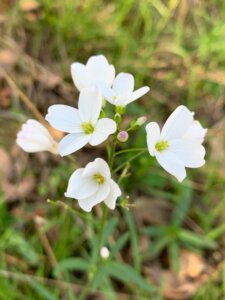 Milkmaids (Cardamine californica)
Milkmaids (Cardamine californica)
Look for four-petaled blooms ranging from creamy white to blush pink, dancing on thin stems about a foot above the ground. Now through May, you’ll most often spy this cheerful member of the mustard family in the shadowy woods or edges of meadows or on north-facing slopes.
If you’re out on the trails during a light rainfall, notice how milkmaids close their petals and nod the flowers to the ground to protect the bright yellow pollen from getting wet.
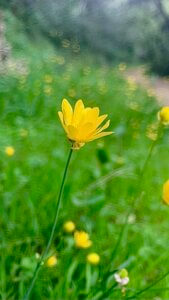 Buttercups (Ranunculus californicus)
Buttercups (Ranunculus californicus)
Synonymous with spring, these common wildflowers feature a simple whorl of saffron-colored petals, so shiny they look as if they’ve been dipped in shellac. Though they tolerate drought, they can grow particularly well with damp feet, so look for them growing in dense patches in shallow ditches along roadsides.
Though Miwok and other tribes would dry and roast the seeds to make flour, the plants are actually quite poisonous when fresh or improperly prepared and can even cause skin irritation, so hands off!
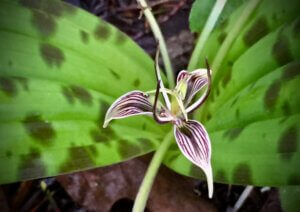 Fetid adder’s tongue (Scoliopus bigelovii)
Fetid adder’s tongue (Scoliopus bigelovii)
The bizarre name for this hard-to-spy lily refers to two key features. The first applies to tiny flowers—about the size of your pinky’s fingernail. The blooms, featuring a trio of creamy-white petals sporting burgundy pinstripes, give off the faint scent of rotten (or fetid) meat, which aims to attract pollinating gnats. The “adder’s tongue” part of the name refers to the lily’s large, leathery leaves (glossy green with tan splotches), which poke out of the ground just after the flowers.
Since the flowers can be tough to spot, look for the green tips of the leaves poking out of the soil, then search for the flowers. Target the shady banks rising above the wettest, shadiest parts of Shoreline and Bay View Trails—it helps to get low to the ground and scan for the flowers. Once you see one little bloom, you’ll get the hang of it, and likely spot more.
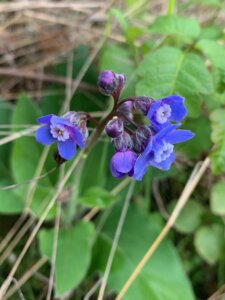 Pacific hound’s tongue (Adelinia grandis)
Pacific hound’s tongue (Adelinia grandis)
Another early wildflower with a quirky name is this shade-loving member of the borage family. A native that thrives in shady woodlands from British Columbia south to California, this plant, also called Western houndstongue, is a cheerful find in early spring. Look for a cluster of bright blue, five-petal flowers, each bloom with a “white-eye” center, growing on a tall shoot rising from the forest floor. The plant’s name comes from the low whorl of ground-hugging leaves, each one a long, floppy oval that hints at the panting tongue of a bloodhound.
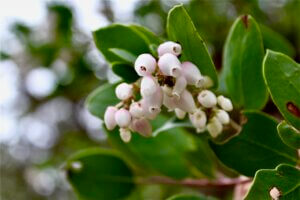 Marin manzanita (Arctostaphylos virgata)
Marin manzanita (Arctostaphylos virgata)
With its polished red bark and gracefully twisted branches, this handsome shrub starts blooming as early as January. The charming flowers, ranging from cream to pale pink, resemble upside-down urns. Because they bloom so early when nectar tends to be scarce, these flowers provide an important food source for bees and other insects. Manzanita blooms also offer food for native Anna’s hummingbirds, which don’t migrate to warmer climes like other local hummers.
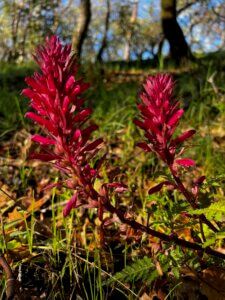 Warrior’s plume (Pedicularis densiflora)
Warrior’s plume (Pedicularis densiflora)
With its claret-color plume rising above a whorl of dusty green, fern-like leaves, warrior’s plume seems as benign as any other plant—growing, flowering, seeding—basically just being a plant. But come upon a profusion of warrior’s plumes flourishing beneath the smooth, mahogany-hued branches of manzanita bushes or taller madrone trees, and you’ve likely found Indian warriors growing as parasites, sucking nutrients from the roots of the manzanita and madrone.
It’s an interesting split-personality for this member of the Broomrape family. Technically, the plant has enough chlorophyll to make it on its own. But given the chance, warrior’s plumes will attach to the roots of host plants, poaching water and nutrients to increase the plant’s vigor and chances of survival.
For one more of this plant’s secrets, get down low to peek inside the red “petals,” actually modified leaves called bracts. Look for the plant’s tiny true flower, or corolla, described in the late 1800s by botanist Ida Mae Twitchell Blochman as “a long and slender mitten, just fit for some high-born fairy’s hand.”
Check out our gallery of wildflowers regularly seen at China Camp State Park. For more information on local wildflowers, visit the California Native Plant Society’s Calscape resource, featuring photos, distribution maps, and other cool details.
—Harriot Manley/FOCC volunteer

